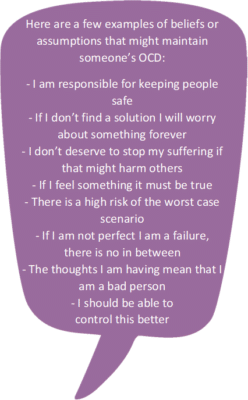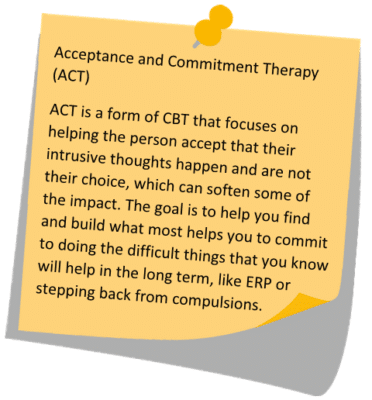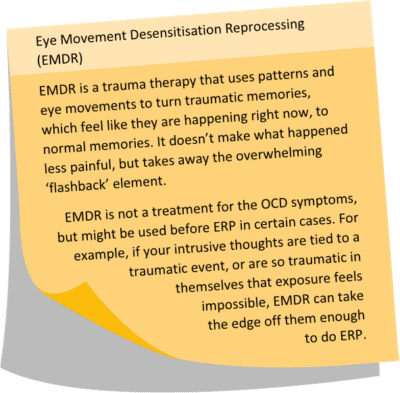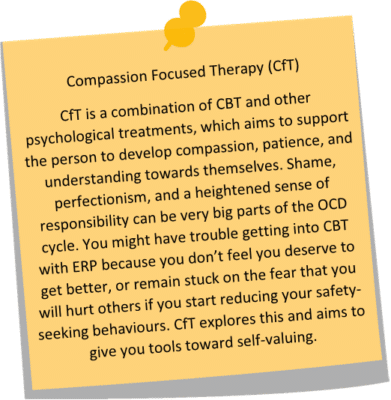.
The only proven and recommended therapy for OCD and related conditions is Cognitive Behavioural Therapy that includes Exposure and Response Prevention. This is often referred to as ‘CBT with ERP’. It is considered the golden standard of OCD treatment, and is available at all levels of the NHS mental health system.
You can learn more about what you can expect from this type of therapy in the rest of this pack. Please see the links on the right-hand side of this page.
Cognitive Behavioural Therapy (CBT) is an umbrella term for a type of talking therapy that aims to understand an individual’s patterns and change them through new practices. At the base of it, you and your therapist would learn how your feelings, thoughts, and behaviours affect each other and keep you stuck in unnecessary, upsetting, or harmful cycles. As the name implies, this involves a cognitive element, which looks at assumptions and how you think, and a behavioural element, which involves intentionally practicing new reactions. When treating OCD, the behavioural side of the therapy must include Exposure and Response Prevention, which is a particular strategy that works very directly on the OCD cycle.
Historically, the two elements have been developed separately, so there are also such things as Cognitive Therapy and Behavioural Therapy. The combination of the two is considered the best practice, as research has shown it to be more successful, and because it gives you more ‘angles’ to tackle the problem from. Even in their separate forms there tends to be an overlap between the two therapies, so the combination usually allows someone to get the most out of their sessions.
CBT does not focus on why you are obsessing over a particular topic or where the intrusive thoughts come from, but rather on making a change to the here and now that you are experiencing. OCD is a constant loop, so the goal is to get you out of it, and what pushed you into it in the first place isn’t part of that. Like any learning process it takes time, motivation, and practice to work. CBT is a very active and hands-on therapy, with the therapist as a guide. You will be doing the majority of the work and should be given homework to do between sessions, which will integrate the learning into day to day life.
Cognitive element
The goal of cognitive therapy is to make a change to the beliefs or assumptions that keep the OCD cycle going, helping you understand that you are reacting to uncertainty rather than real risk. These will be different from person to person, so at the beginning you and your therapist will work on identifying your individual experience. The therapist can offer ‘psychoeducation’, which means teaching you about how the brain works and what might be going on, which can help to better understand and explain what’s happening.
Depending on what the thought process is, a therapist will work through different cognitive strategies with you, which will take up part of the therapy sessions and homework. The right way to challenge current ways of thinking will change from person to person. For example, an exercise called ‘Theory A/Theory B’ can teach you to look at the evidence for and against a worry, without getting stuck in using it as reassurance. Another practice might be around changing the focus around the thoughts, so that instead of getting stuck on whether they’re true or not, you would learn to value whether they’re useful. If you have BDD or your obsessions revolve around self-worth, there might also be a focus on identifying other things that can impact positively on self-esteem. Just like there are infinite manifestations of OCD, what someone needs in therapy will vary. At the heart of it, though, cognitive work aims to reframe the context that is giving OCD so much power.
The cognitive element of CBT for OCD can also be an important part of helping you take part in the behavioural element. ERP can be very challenging, as is explained below, and takes a lot of commitment. Cognitive work can also help you work up to ERP and better prepare for it, so that you can stick to it when the time comes and make the strongest changes. Some people might find that ERP is too difficult for them to really commit to, or that the idea of it makes them too anxious. In these cases, cognitive therapy on its own can be offered, and the hope is that this helps the person both manage their OCD better and feel better able to try ERP in the future.
Behavioural element
The behavioural part of CBT focuses on the reactions, rather than beliefs, that keep the cycle going. In the case of OCD this is the compulsions. One key aspect of this is learning about how anxiety works, how it is felt in the body, and why it causes the responses or behaviours that it does. Through this understanding and guidance from the therapist, you can then learn to respond in a new way to anxiety, without compulsions. This has to be a gradual process set at the right pace for you. The goal is not simply to choose a new reaction, but to build one.
Exposure and Response Prevention (ERP) works to reverse the OCD vicious cycle. The meaning that OCD attaches to intrusive thoughts causes you to feel anxious and responsible, so you use compulsions to get relief from the anxiety. This relief then reinforces the brain’s assumption that the thoughts are bad, so the anxiety about them keeps getting worse. Through ERP, you practice the opposite – by choosing anxiety instead of running from it, it becomes less intense with time, and the brain re-learns how to respond to it without compulsions.
Exposure involves taking part in an action that will bring on the anxiety. Response Prevention means making the active choice to stay anxious instead of doing a compulsion. ERP must be done in a gradual way, because you are learning and practicing a different way of going about life and this takes time. This is called graded exposure and can be done in lots of different ways. You might start off with small things that only bring on a bearable amount of anxiety and then build up from there, or you might only hold back compulsions for a few minutes at the beginning and wait longer and longer each time. You can even use your imagination for them. Eventually, ERP exercises will involve doing quite scary things and then waiting for the anxiety to go away by itself, without doing any compulsions.

Like with all mental health conditions, what someone’s OCD looks like and what gets in the way of recovery will change from person to person. Some people have some extra barriers that make the therapy harder to commit to or slower to work. This might be because of the severity of your symptoms, some internal beliefs that are particularly strong because of your life experiences, or because you have other mental health conditions that make your needs more complex.
Sometimes, a CBT therapist might suggest trying a different therapy or technique based on your individual experience or barriers. If your therapist is suggesting something that isn’t the recommended treatment, it should be to help you engage with CBT and ERP,

not to replace them. Your therapist should always be able to explain why they are doing somethingand how it will help with OCD.
Here are a few examples of therapies that might be offered alongside CBT with ERP.

